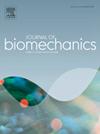Lower limb kinematics and kinetics of people with through-knee amputation compared to individuals with transfemoral amputation and able-bodied controls during walking
IF 2.4
3区 医学
Q3 BIOPHYSICS
引用次数: 0
Abstract
Lower-limb amputations negatively affect quality of life and increase the risk of secondary health conditions. Through-Knee Amputation (TKA), although less commonly performed than Transfemoral Amputation (TFA), offers potential biomechanical advantages due to preserved femur length and associated musculature. This study aimed to characterize gait biomechanics of individuals with unilateral TKA, TFA and able-bodied controls. Gait biomechanics of seven individuals with unilateral TFA, four with unilateral TKA, and nine able-bodied controls were evaluated with a 3D motion tracking system and force plates. Joint angles and moments at the ankle, knee, hip, and pelvis were computed and compared between groups. Individuals with TKA’s walking mechanics displayed fewer differences with able bodied controls compared to individuals with TFA. Individuals with TKA had greater hip Range Of Motion (ROM) on the amputated side than TFA (52.71° ± 7.3°, 40.38° ± 5.4° respectively, p < 0.005). TFA individuals had higher pelvic antero/posterior tilt ROM compared to controls (11.26° ± 7.2° and 3.1° ± 1.5° respectively, p < 0.005) but TKA and controls were not statistically different from each other. TKA individuals and able-bodied controls both had lower peak hip extension moments on the intact side than individuals with TFA (1.05 (±0.43), 1.05 (±0.39) and 1.83 (±0.28) N.m.kg−1, p < 0.005, p < 0.05 respectively). These findings suggest that TKA may offer biomechanical advantages over TFA, particularly in preserving gait biomechanics closer to able-bodied controls, underscoring the potential advantages of this procedure for individuals requiring lower-limb amputation.
求助全文
约1分钟内获得全文
求助全文
来源期刊

Journal of biomechanics
生物-工程:生物医学
CiteScore
5.10
自引率
4.20%
发文量
345
审稿时长
1 months
期刊介绍:
The Journal of Biomechanics publishes reports of original and substantial findings using the principles of mechanics to explore biological problems. Analytical, as well as experimental papers may be submitted, and the journal accepts original articles, surveys and perspective articles (usually by Editorial invitation only), book reviews and letters to the Editor. The criteria for acceptance of manuscripts include excellence, novelty, significance, clarity, conciseness and interest to the readership.
Papers published in the journal may cover a wide range of topics in biomechanics, including, but not limited to:
-Fundamental Topics - Biomechanics of the musculoskeletal, cardiovascular, and respiratory systems, mechanics of hard and soft tissues, biofluid mechanics, mechanics of prostheses and implant-tissue interfaces, mechanics of cells.
-Cardiovascular and Respiratory Biomechanics - Mechanics of blood-flow, air-flow, mechanics of the soft tissues, flow-tissue or flow-prosthesis interactions.
-Cell Biomechanics - Biomechanic analyses of cells, membranes and sub-cellular structures; the relationship of the mechanical environment to cell and tissue response.
-Dental Biomechanics - Design and analysis of dental tissues and prostheses, mechanics of chewing.
-Functional Tissue Engineering - The role of biomechanical factors in engineered tissue replacements and regenerative medicine.
-Injury Biomechanics - Mechanics of impact and trauma, dynamics of man-machine interaction.
-Molecular Biomechanics - Mechanical analyses of biomolecules.
-Orthopedic Biomechanics - Mechanics of fracture and fracture fixation, mechanics of implants and implant fixation, mechanics of bones and joints, wear of natural and artificial joints.
-Rehabilitation Biomechanics - Analyses of gait, mechanics of prosthetics and orthotics.
-Sports Biomechanics - Mechanical analyses of sports performance.
 求助内容:
求助内容: 应助结果提醒方式:
应助结果提醒方式:


